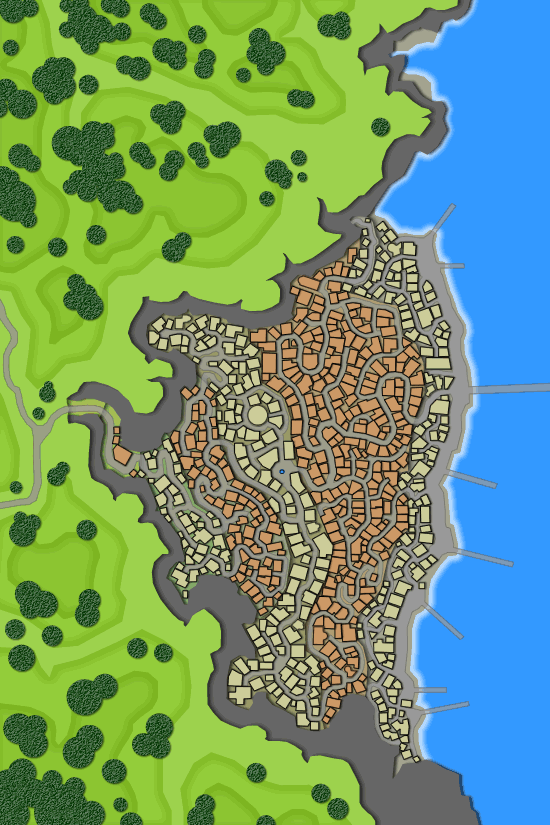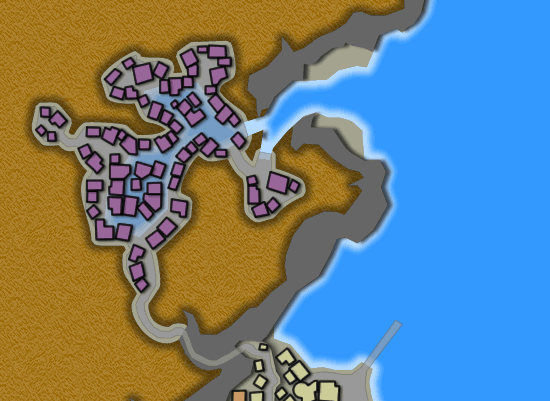The Stairway to Ælyrēa
Crouching within a stone canyon along the northern sea wall of Ildûn lies the quiet Ēōyn town of Cwæyl.The town of Cwæyl is all but invisible from the hills above except for a winding shell road that conspicuously disappears at the cliff’s edge. At the sea wall’s edge, the road descends sharply, cutting a deep furrow into the ground. As the road turns around the first bend, the cliff-side town comes into view, built against the walls of the canyon. Here the road begins a series of steep switchbacks, each turn shored up by a series of stone walls that mark the Five Stairs of Cwæyl. Smaller avenues branch from the main road, fronted by modest stone dwellings pressing tightly against one another. Half-way down the crushed shell path is a small courtyard with an open well. Four wooden winches encircle the well, available to anyone with a pail; it is the only well in the town. From the courtyard the road continues further downward, passing the kiosks of merchant row, which stand within archways built into the road’s own retaining wall. Beyond these alcoves is the Spirit Horse Inn, where most visitors seek a night’s rest. Beyond the inn, the road switches back a few more times before reaching the wharf far below.
At the base of the town, a series of wooden piers extend from the wharf. The largest pier is supported by barnacle-clad stone posts. Atop each alternating stone posts, a queer metal lantern glows with a wavering ghost light. By these strange lights, fishermen can find the dock at night. Some claim that when the fog grows thick around Cwæyl the lights exit their lanterns and guide ships back through the mists.
Perhaps the most curious feature of Cwæyl (and other Ēōyn towns), are the carved glyphs that can be found on most buildings in the sea side town. The oldest carvings are worn smooth by centuries of wind and sea spray, but newer images also peer from unlikely places. These glyphs were placed by the residents of Cwæyl. Some are meant to scare away evil spirits while others are intended to welcome good ones. Although use of the glyphs has changed over the centuries, their images are still widely used. Wealthier residents of the town have their doors carved into grotesques inset with precious stones. The Grotto thieves know better than to defile the glyphs of Ælyra.
Wards
The Town of Cwæyl is divided into five regions called Stairs and a subterranean region known as the Grotto. Each Stair (or terrace) has a distinct personality. The Stairs are numbered started at the wharf and progressing inland.
- First Stair. A long shell wharf extends north to south along the sea’s edge. The structures along the First Stair are mostly stores, warehouses, sailor taverns, and boarding dens for dockworkers. Each stone and wood building is weathered to a dull soft gray. The avenues and alleyways are commonly littered with vagrants, drunks, addicts, and prostitutes.
- Second Stair. The largest ward of the town of Cwæyl is the Second Stair. The buildings here are better maintained than those of the First Stair. The residents of this ward are typically of a higher social class, as sailors and dockworkers rarely find reason to climb to the Second Stair. Residents of this ward are typically farmers, lumbermen, and miners who march in long winding lines to the upper plains every morning.
- Third Stair. The middle Stair is home to most of Cwæyl’s shops and markets. Visitors to the town usually can find reasonable accommodations in this ward (rf. Spirit Horse Inn). It is also the location of the Temple of Ælyrēa and Gældgud’s Tower.
- Fourth Stair. With the exception of those buildings lining the main road, the Fourth Stair is home to the wealthiest residents of Cwæyl. In addition to wealthy residents, the Fourth Stair also hosts a number of government buildings, guild offices, and a Shrine to Wylùragēa.
- Fifth Stair. The topmost tier of the town of Cwæyl is strangely vacant. All of the windowless buildings of this ward are constructed with stone. Each building is a mausoleum devoted to a different clan. Many of the buildings are many centuries old, bearing the names of families no longer remembered. The practice of building necropolises was not originally an Ēōyn practice, but was adopted from the Cult of Drāūn.
- The Grotto. An elevated roadway reaches along the cliff face at the northwest corner of the First Stair. Accessible only from the higher streets, one traveling along this passage soon enters a tunnel into the sea wall. The tunnel leads to a hollow area beneath the cliff. Here an old wooden wharf extends back into the darkness, offering a creaking surface above the breaking waves below. Once a flooded cove, the Grotto now hosts a handful of wooden buildings. The Grotto has an unsavory reputation that extends well beyond the town. Only unemployed sailors and vagrants dwell there. There is a round hatch in the center of the Grotto where undesirables are taken and tied to the wooden posts below. Their screams can often be heard over the breaking waves until the tide rolls in to silence them.
Landmarks
- Gældgud’s Tower. A stone tower rises on the north end of the Third Stair. Every stone of the tower is carved into a grotesque face that was been worn indistinct by centuries of wind and saltwater spray. The west facing front door is heavy wood inlaid with gold. The carvings depict six scenes outlining the epic of Luçgre, an ancient Ēōyn hero that defended Ælyra from an army of Lesser Jōtun. In ancient times, Gælgud was a magician who mastered the Dekàli and native magics of the region. His tower is said to have been warded with exotic and deadly protections that malfunctioned, trapping the magician forever in his tower. No one has entered or exited the tower in almost 700 years.
- Shrine to Wylùragēa. A rectangular stone building whose back walk is a large carved totem that has likely stood on the same spot long before the Fourth Stair was built. Before the totem is a circular fire-pit surrounded by iron hooks that arch over the pit’s rim. During ceremonies, incense censers are hung from these hooks. At the front of the hall is a pump well and a large shallow copper bowl. The walls of the Shrine are brightly painted with images of an ethereal woman offering handfuls of water to visitors. The Shrine priest is Amègdre of Wylùragēa.
- Spirit Horse Inn. The Spirit Horse Inn is the most popular attraction for visitors to the town of Cwæyl. Both sailors and land travelers alike are welcomed and promised a comfortable stay and warm food. The rooms are small by most standards, but everything in the town is scaled down to make the most of finite real estate. Although there are three private rooms, most visitors share beds in one of the two common areas. The innkeeper is Dæmègd of Elurd.
- The Stone Face. Of all the totems of Cwæyl, the most famous is the Stone Face. Near the top of the main road, before the second switchback, stands a house-sized stone carved into the likeness of an impish bearded face. Inset into the left eye of the image is a pale green stone, while the right eye is a black socket large enough to fit one’s fist inside. Town rumors claim that objects placed inside the eye of the Stone Face overnight are imbued with supernatural magics. Others claim that you must leave offerings if you want the spirits to bless the object within, otherwise they will curse the item. Perhaps the most well known story of the Stone Face involved a sailor who placed a deck of cards inside the eye. From that time forward, the story claims, he could not lose a card game when using deck. When his mates grew suspicious of his luck, they tied him to the post beneath the Grotto hatch and left town with his cards.
- Temple of Ælyrēa. A simple stone building of the Third Stair is home to Cwæyl’s Temple of Ælyrēa. The interior of this ancient building is filled with wooden benches arranged around a central fire-pit. The walls of the Temple were once vividly painted with images of the God-spirit, but those images have long since faded and cracked. The ceiling frescoes are now black with centuries of smoke from fires and candles. The Temple priest is Sohgrēe of Ælyrēa, an old gentleman that has served at the Temple since 599 DR.
Groups
- Order of Wylùragēa. The town of Cwæyl hosts an elite order of Spiritriders known as the Order of Wylùragēa. Devoted to the protection of Cwæyl and the surrounding countryside, the Order is renown throughout the region for their ongoing war against the Ildûnyr. The Order maintains its headquarters within Cwæyl which supports a number of keeps throughout the region. The Order Commander is Rider Oedlyn of Sulde.
History
The town of Cwæyl has a long history.
During the Old Empire’s thousand year occupation of Ælyra (circa 120-1246 HK), the town was used as a northern naval outpost for Dekàli ships trading with the Spiráçi Archipelago and Vulmùra. During this period, the town’s area extended into the hills above the sea wall and was supported by a sizable network of farms and inland trading routes. Since the Empire’s collapse, the upper structures were abandoned. Today, only the most minimal foundations remain, and those are covered by plains grass.
Before the arrival of Savàrin the White in the south, the town of Cwæyl was a prosperous fishing and market village of thatched stone huts. Ancient charters show that in the distant past, clans would converge on the town to trade with Zultàyi merchants from the north. Following the Dekàli invasion however, the clans grew skeptical of outsiders and ceased all dealings with the Zultàya.

